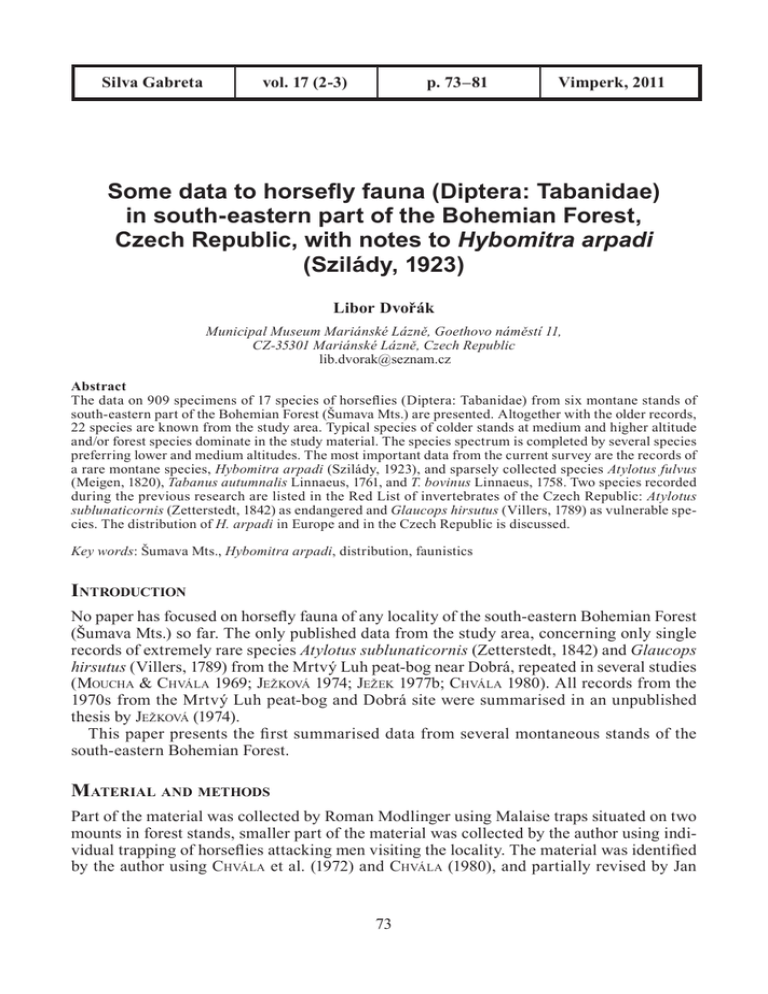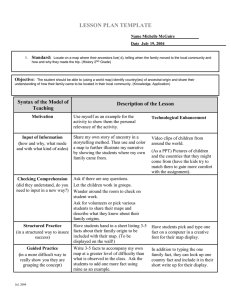in south-eastern part of the Bohemian Forest, Czech Republic, with
advertisement

Silva Gabreta vol. 17 (2-3) p. 73–81 Vimperk, 2011 Some data to horsefly fauna (Diptera: Tabanidae) in south-eastern part of the Bohemian Forest, Czech Republic, with notes to Hybomitra arpadi (Szilády, 1923) Libor Dvořák Municipal Museum Mariánské Lázně, Goethovo náměstí 11, CZ-35301 Mariánské Lázně, Czech Republic lib.dvorak@seznam.cz Abstract The data on 909 specimens of 17 species of horseflies (Diptera: Tabanidae) from six montane stands of south-eastern part of the Bohemian Forest (Šumava Mts.) are presented. Altogether with the older records, 22 species are known from the study area. Typical species of colder stands at medium and higher altitude and/or forest species dominate in the study material. The species spectrum is completed by several species preferring lower and medium altitudes. The most important data from the current survey are the records of a rare montane species, Hybomitra arpadi (Szilády, 1923), and sparsely collected species Atylotus fulvus (Meigen, 1820), Tabanus autumnalis Linnaeus, 1761, and T. bovinus Linnaeus, 1758. Two species recorded during the previous research are listed in the Red List of invertebrates of the Czech Republic: Atylotus sublunaticornis (Zetterstedt, 1842) as endangered and Glaucops hirsutus (Villers, 1789) as vulnerable species. The distribution of H. arpadi in Europe and in the Czech Republic is discussed. Key words: Šumava Mts., Hybomitra arpadi, distribution, faunistics INTRODUCTION No paper has focused on horsefly fauna of any locality of the south-eastern Bohemian Forest (Šumava Mts.) so far. The only published data from the study area, concerning only single records of extremely rare species Atylotus sublunaticornis (Zetterstedt, 1842) and Glaucops hirsutus (Villers, 1789) from the Mrtvý Luh peat-bog near Dobrá, repeated in several studies (MOUCHA & CHVÁLA 1969; JEŽKOVÁ 1974; JEŽEK 1977b; CHVÁLA 1980). All records from the 1970s from the Mrtvý Luh peat-bog and Dobrá site were summarised in an unpublished thesis by JEŽKOVÁ (1974). This paper presents the first summarised data from several montaneous stands of the south-eastern Bohemian Forest. MATERIAL AND METHODS Part of the material was collected by Roman Modlinger using Malaise traps situated on two mounts in forest stands, smaller part of the material was collected by the author using individual trapping of horseflies attacking men visiting the locality. The material was identified by the author using CHVÁLA et al. (1972) and CHVÁLA (1980), and partially revised by Jan 73 Ježek and Theo Zeegers. Some voucher specimens are deposited in the author’s private collection as well as in the collection of the Šumava National Park administration, Kašperské Hory. The nomenclature follows CHVÁLA (2009) with the only exception briefly commented in the text. LOCALITIES The survey was carried out on six mountaneous localities and eight sublocalities at the altitudes between 750 and 1280 m a.s.l. The exact data are listed as follows: locality name, grid code of the faunistic square (e.g., PRUNER & MÍKA 1996), biotope, altitude, method, date of survey, author of trapping, and the locality abbreviation used in the text. Dobrá, 7148, Radvanovický Hřbet ridge, clearing in mixed forest, 840 m a.s.l., individual trapping, 17 Jul 2006, L. Dvořák leg. (DOB). Kamenná Hlava, 7148, meadows at ancient village, 970 m a.s.l., individual trapping, 22 Jun 2007, L. Dvořák leg. (KAM). Krásná Hora, 7148, peaty meadow, 880 m a.s.l., individual trapping, 22 Jun 2007, L. Dvořák leg. (KRA). Mrtvý Luh, 7149, peat-bog, 750 m a.s.l., individual trapping, 13 Jul 2005, L. Dvořák leg. (MRT). Smrčina Mt., 7249, pine-beech forest, 1200 m a.s.l., Malaise trap, 2006, R. Modlinger leg. (SM6). Smrčina Mt., 7249, pine forest, 1280 m a.s.l., Malaise trap, 2007, R. Modlinger leg. (SM7). Trojmezná Mt., 7248, pine forest, 1200 m a.s.l., Malaise trap, 2006, R. Modlinger leg. (TR6). Trojmezná Mt., 7248, pine forest, 1230 m a.s.l., Malaise trap, 2007, R. Modlinger leg. (TR7). RESULTS AND DISCUSSION List of species The species are listed alphabetically. The data in the list are: locality abbreviation, date of trapping or trapping period, and number of specimens including sex. Notes about published data are added. The distribution and habitat preferences of each species in the Czech Republic are also included. All are adopted from CHVÁLA (1980), if no other reference is added. Atylotus fulvus (Meigen, 1820) SM7: 20 May–8 Jun 2007, 1 ♀. Known from the Mrtvý Luh peat-bog (JEŽKOVÁ 1974). Rarely collected species of different biotopes from lowlands to mountains. According to present knowledge, this species seems to be rarer recently than in the past. No new record was published from the Czech Republic during the last 30 years, the record published by JEŽEK et al. (2005) is of older date. Atylotus sublunaticornis (Zetterstedt, 1842) No new records, known from the Mrtvý Luh peat-bog (MOUCHA & CHVÁLA 1969; JEŽKOVÁ 1974; JEŽEK 1977b; CHVÁLA 1980). Very rare peat-bog species known from several stands in southern Bohemia only. Endangered species according to JEŽEK & BARTÁK (2005). 74 Chrysops caecutiens (Linnaeus, 1758) MRT: 13 Jul 2005, 3 ♀♀. Known from Dobrá (JEŽKOVÁ 1974). Common species of wet stands in forested regions, also in mountains. Chrysops relictus Meigen, 1820 No new records, known from the Mrtvý Luh peat-bog and Dobrá (JEŽKOVÁ 1974). Common species of wet stands, rare in mountains. Glaucops hirsutus (Villers, 1789) No new records, known from the Mrtvý Luh peat-bog (CHVÁLA 1980). Rare mountain species known from several localities only. Vulnerable species according to JEŽEK & BARTÁK (2005). Remark: MALLY (1987, 1989) ranked Glaucops as subgenus of Tabanus; his conclusions require more detailed study in the future. Haematopota pluvialis (Linnaeus, 1758) DOB: 17 Jul 2006, 10 ♀♀; KAM: 22 Jun 2007, 6 ♀♀; KRA: 22 Jun 2007, 1 ♀; MRT: 13 Jul 2005, 4 ♀♀. Known from the Mrtvý Luh peat-bog and Dobrá (JEŽKOVÁ 1974). Very common species of various biotopes from lowlands to mountains. Haematopota subcylindrica Pandellé, 1883 DOB: 17 Jul 2006, 1 ♀. Relatively common species of various biotopes from lowlands to mountains. Heptatoma pellucens (Fabricius, 1776) MRT: 13 Jul 2005, 2 ♀♀. Known from the Mrtvý Luh peat-bog (JEŽKOVÁ 1974). Common species of various stands. Hybomitra arpadi (Szilády, 1923) DOB: 17 Jul 2006, 1 ♀; SM6: 26 Jun–5 Jul 2006, 1 ♀; 5–13 Jul 2006, 1 ♀; 13–20 Jul 2006, 11 ♀♀; 20–27 Jul 2006, 2 ♀♀; SM7: 8 Jun–1 Jul 2007, 4 ♀♀; TR6: 26 Jun–5 Jul 2006, 1 ♀. It is a rare species in central Europe, where it occurs in mountains in forests and their surroundings. For more detailed comments see a special section below. Hybomitra aterrima var. auripila (Meigen, 1820) DOB: 17 Jul 2006, 4 ♀♀; KAM: 22 Jun 2007, 2 ♀♀; SM6: 12–14 Jun 2006, 2 ♀♀; 14–26 Jun 2006, 1 ♀; 26 Jun–5 Jul 2006, 8 ♀♀; 5–13 Jul 2006, 13 ♀♀; 13–20 Jul 2006, 62 ♀♀; 20–27 Jul 2006, 7 ♀♀; SM7: 20 May–8 Jun 2007, 7 ♀♀; 8 Jun–1 Jul 2007, 2 ♂♂, 156 ♀♀; TR6: 14–26 Jun 2006, 13 ♀♀; 26 Jun–5 Jul 2006, 14 ♀♀; 5–13 Jul 2006, 7 ♀♀; TR7: 7 Jun–1 Jul 2007, 8 ♀♀; 1 Jul–20 Sep 2007, 1 ♀. All recorded specimens belong to the variety auripila (Meigen, 1820), listed as a valid species by many authors, also in the most recent checklist of the Czech Republic (CHVÁLA 2009). This new taxonomic combinations was published by SCHACHT (1994) who found intermediate specimens. The name was accepted, e.g., by BERGERSEN et al. (2004). Common species of wet stands preferring submountain and mountain stands. Hybomitra bimaculata (Macquart, 1826) DOB: 17 Jul 2006, 1 ♀; SM6: 13–20 Jul 2006, 7 ♀♀; 20–27 Jul 2006, 3 ♀♀; 26 Jun–5 Jul 2006, 2 ♀♀; 5–13 Jul 2006, 4 ♀♀; SM7: 8 Jun–1 Jul 2007, 18 ♀♀; TR6: 14–26 Jun 2006, 1 ♀; 26 Jun–5 Jul 2006, 1 ♀; 5–13 75 Jul 2006, 1 ♀; TR7: 7 Jun–1 Jul 2007, 1 ♀. Known from the Mrtvý Luh peat-bog (JEŽKOVÁ 1974). Common species of wet stands, relatively rare in mountains. Hybomitra distinguenda (Verrall, 1909) DOB: 17 Jul 2006, 4 ♀♀; MRT: 13 Jul 2005, 1 ♀; SM6: 26 Jun–5 Jul 2006, 10 ♀♀; 5–13 Jul 2006, 11 ♀♀; 13–20 Jul 2006, 61 ♀♀; 20–27 Jul 2006, 22 ♀♀; 27 Jul–16 Aug 2006, 2 ♀♀; SM7: 8 Jun–1 Jul 2007, 64 ♀♀; TR6: 14–26 Jun 2006, 5 ♀♀; 5–13 Jul 2006, 4 ♀♀; TR7: 7 Jun–1 Jul 2007, 6 ♀♀. Known from the Mrtvý Luh peat-bog (JEŽKOVÁ 1974). Common species of wet forested regions, more common in mountains. Hybomitra kaurii Chvála MRT: 13 Jul 2005, 2 ♀♀. & Lyneborg, 1970 Known from the Mrtvý Luh peat-bog (JEŽKOVÁ 1974). A tundra species, uncommon in pond regions, montaneous peat-bogs, and damp meadows. Hybomitra lundbecki Lyneborg, 1959 MRT: 13 Jul 2005, 1 ♀; SM6: 26 Jun–5 Jul 2006, 3 ♀♀; 13–20 Jul 2006, 2 ♀♀. Known from the Mrtvý Luh peat-bog (JEŽKOVÁ 1974). Common species of forested wet stands, mainly at lower altitudes, but occurring also in mountains. Hybomitra micans (Meigen, 1804) KAM: 22 Jun 2007, 2 ♀♀; MRT: 13 Jul 2005, 1 ♀; SM6: 12–14 Jun 2006, 10 ♀♀; 26 Jun–5 Jul 2006, 20 ♀♀; 13–20 Jul 2006, 5 ♀♀; 20–27 Jul 2006, 2 ♀♀; SM7: 20 May–8 Jun 2007, 39 ♀♀; 8 Jun–1 Jul 2007, 77 ♀♀; TR6: 14–26 Jun 2006, 7 ♀♀; 26 Jun–5 Jul 2006, 2 ♀♀; TR7: 21 May–7 Jun 2007, 1 ♀. Known from the Mrtvý Luh peat-bog (JEŽKOVÁ 1974). Common species in the Czech Republic, mainly on wet stands; it prefers mountains. Hybomitra tropica (Linnaeus, 1758) No new records, known from the Mrtvý Luh peat-bog (JEŽKOVÁ 1974). A species preferring damp forested regions, sparsely found from lowlands to mountains, but only individually and rarely. Tabanus autumnalis Linnaeus, 1761 KAM: 22 Jun 2007, 1 ♀. Widespread species in the Czech Republic, but everywhere occurring in small numbers. It is relatively common in lowlands and medium altitudes, but only occasionally occurring in highlands and mountain valleys. Tabanus bovinus Linnaeus, 1758 DOB: 17 Jul 2006, 2 ♀♀; KAM: 22 Jun 2007, 1 ♀. Uncommon species in forested regions of lowlands and highlands, rather rare in mountains. All older published data require revisions due to often confusions with much more common T. sudeticus (L. DVOŘÁK, unpubl., ZEEGERS & VAN HAAREN 2000). Tabanus bromius Linnaeus, 1758 KAM: 22 Jun 2007, 1 ♀. Known from the Mrtvý Luh peat-bog (JEŽKOVÁ 1974). 76 Common species of various biotopes from lowlands to mountains. Tabanus cordiger Meigen, 1820 No new records, known from the Mrtvý Luh peat-bog (JEŽKOVÁ 1974). Uncommon lowland species, which could be rarely found in lower parts of mountains. Tabanus maculicornis Zetterstedt, 1842 DOB: 17 Jul 2006, 3 ♀♀; KAM: 22 Jun 2007, 2 ♀♀; MRT: 13 Jul 2005, 1 ♀; SM6: 12–14 Jun 2006, 1 ♀; 26 Jun–5 Jul 2006, 5 ♀♀; 5–13 Jul 2006, 19 ♀♀; 13–20 Jul 2006, 22 ♀♀; 20–27 Jul 2006, 13 ♀♀; SM7: 20 May–8 Jun 2007, 2 ♀♀; 8 Jun–1 Jul 2007, 55 ♀♀; TR6: 14–26 Jun 2006, 11 ♀♀;5–13 Jul 2006, 3 ♀♀; TR6: 26 Jun–5 Jul 2006, 2 ♀♀; TR7: 21 May–7 Jun .2007, 1 ♀; 7 Jun–1 Jul 2007, 1 ♀. Known from the Mrtvý Luh peat-bog (JEŽKOVÁ 1974). Common species occurring on a great scale of biotopes. Tabanus sudeticus Zeller, 1842 DOB: 17 Jul 2006, 1 ♀; SM6: 14–26 Jun 2006, 1 ♀; 26 Jun–5 Jul 2006, 1 ♀; SM7: 8 Jun–1 Jul 2007, 3 ♀♀. Common mountain species. General comments Altogether 909 specimens of 17 species from seven genera of horseflies were found on the territory under study during the current survey (see Table 1). Together with older records summarised by JEŽKOVÁ (1974) and CHVÁLA (1980), 22 horsefly species are known from the study area. From the Czech Republic’s point of view, typical montane species or species being more common at mountains are present in the material: Atylotus sublunaticornis, Hybomitra arpadi, H. aterrima var. auripila, H. kaurii, H. micans, Tabanus sudeticus, and Glaucops hirsutus. Species preferring lower and medium altitudes are Tabanus autumnalis, T. bovinus, T. cordiger, and partly also Hybomitra bimaculata and Chrysops relictus. None species of Haematopota spp. was caught on any locality using Malaise trap, while H. pluvialis was the most common species on localities Dobrá, Kamenná Hlava, and Mrtvý Luh peat-bog (individual collecting). The most common species in Malaise traps on the Smrčina Mt. and Trojmezná Mt. were H. aterrima var. auripila and H. distinguenda, on some stands also H. micans and T. maculicornis (Table 1). Two species, H. aterrima var. auripila and T. maculicornis, were caught on almost all localities and represented the most frequent species in the study area. The record of the only specimen of T. bromius during the current survey could be explained by its evident preference of open stands in the Bohemian Forest (L. DVOŘÁK, unpubl. data). Altogether 16 species of horseflies are known from a single locality, Mrtvý Luh peat-bog (Table 1). Hybomitra arpadi (Szilády, 1923) Hybomitra arpadi is a Holartcic species of the taiga zone, with a continuous Palaearctic distribution in Scandinavia, Estonia, northern Belarus, Russia, south to the Moscow region and east to Primorye, Korea, and Japan (CHVÁLA et al. 1972; OLSUFJEV 1977). South and southwest of this area, it is also known from the Czech Republic (CHVÁLA 2009), SW Poland (TROJAN 1979), Bavaria in Germany (SCHACHT 2010), Upper Austria (MALLY 1989), Belgium (LECLERCQ 1965), and the Netherlands (ZEEGERS 2002). The data from Lithuania were based on wrong identification and H. arpadi is not known from this country according to present knowledge (DVOŘÁK & PETRAŠIŪNAS 2010). The distribution of H. arpadi in central and west Europe is shown in Fig. 1. 77 Table 1. Presence of horseflies at particular sites during the survey – number (percentage), dominance (>15% of individuals) of a species at the sites is marked in bold. See the section Localities for their codes; MRTD and MRTP are recent (this study) and published records from the Mrtvý Luh peat-bog, respectively; All – all sites together (a single specimen of H. pluvialis from KRA is not listed, but included in the total numbers). Species / Locality DOB KAM MRTD MRTP SM6 SM7 TR6 TR7 All – – 1 (0%) A. fulvus – – – + – 1 (0%) A. sublunaticornis – – – + – – – – – C. caecutiens – – 3 (20%) – – – – – 3 (0%) C. relictus – – – + – – – – – G. hirsutus – – – + – – – – – 10 (38%) 1 (4%) 6 (44%) 4 (26%) + – – – – – – – – – – – – – 2 (13%) + – – – – – – – 2 (14%) – – – – + 15 (4%) 93 (28%) 16 (5%) 106 (31%) 4 (1%) 165 (39%) 18 (4%) 64 (15%) 1 (1%) 34 (47%) 3 (4%) 9 (13%) 9 (47%) 1 (5%) 6 (32%) – – – – H. pluvialis H. subcylindrica H. pellucens H. arpadi H. aterrima var. auripila H. bimaculata 5 (2%) 37 (11%) – – – 116 (27%) 9 (13%) 1 (5%) 21 (2%) 1 (0%) 2 (0%) 21 (2%) 307 (34%) 39 (4%) 190 (20%) 2 (0%) 6 (1%) 166 (18%) + – – – – – – – – – – – – – – – – – – – 1 (7%) – + – – – – – – – + – – – – – 3 (12%) 1 (4%) 2 (14%) 1 (7%) + 2 (11%) – – 57 (13%) 3 (1%) 16 (22%) – 60 (18%) 2 (1%) – – 141 (16%) 6 (1%) 26 14 15 – 334 428 72 19 1 (4%) 4 (15%) 1 (4%) 4 (15%) H. kaurii – – H. lundbecki – – H. micans – 2 (14%) 1 (7%) 2 (13%) 1 (7%) 1 (7%) H. tropica – – – T. autumnalis – 1 (7%) T. bovinus 1 (4%) T. bromius T. cordiger H. distinguenda T. maculicornis T. sudeticus Sum of specimens – + + + + 78 – 1 (0%) 1 (0%) 1 (0%) 909 Fig. 1. The distribution of Hybomitra arpadi (Szil.) in central and west Europe. There are very few published data on this species from the Czech Republic. The first records of H. arpadi from the former Czechoslovakia (and according to knowledge from the whole central Europe) were published by MOUCHA & CHVÁLA (1968) from localities in the Třeboň Basin (Třeboň) and in the Bohemian Forest (Špičák, Hojsova Stráž). JEŽKOVÁ (1974) mentioned several data based on the material deposited in the National Museum in Prague: from the Jizerské Hory Mts. (Horní Polubný), central Bohemia (Jabkenice), the Třeboň Basin (Veselí nad Lužnicí), south-western Bohemia (Životice near Blatná), and also repeatedly from several published localities. JEŽEK (1977a) described larva and pupa of H. arpadi based on the material from localities Jabkenice and Životice (both mentioned in JEŽKOVÁ 1974). JEŽEK (1992) published a single record from the locality Zlín-Paseky, which was the first (and the only according to present knowledge) known from Moravia. ZEEGERS (2002) reported a record from Modrava in the Bohemian Forest. Then JEŽEK et al. (2008) published occurrence on the two localities of the Jizerské Hory Mts. The last published locality is Pamferova Huť in the Bohemian Forest (DVOŘÁK et al. 2010). More data from the Bohemian Forest as well as the records from the Slavkovský Les Mts. and Upper Palatinate Forest (both west Bohemia) were not published yet (L. Dvořák, own data). The distribution of H. arpadi in the Czech Republic is shown in Fig. 2. CONCLUSIONS The horsefly fauna of the study area is formed mainly by several typical montane species, although species of lower and medium altitudes were trapped in small numbers too. The records of Hybomitra arpadi and Atylotus fulvus are the most important result of the current survey. Older records of another rare species, Atylotus sublunaticornis and Glaucops hirsutus, were mentioned or discussed by MOUCHA & CHVÁLA (1969) and CHVÁLA (1980). The total of 22 species from a relatively small montaneous area (six localities) represents an interesting result. In the Czech Republic, these results could be compared with the published data from the Jizerské Hory Mts. and their surroundings (JEŽEK et al. 2008), where 26 species from 52 localities were published. Other studied regions are not situated in mountains the Thayatal National Park and its surroundings, (e.g., JEŽEK et al. 2005). 79 Fig. 2. The distribution of Hybomitra arpadi (Szil.) in the Czech Republic. The Mrtvý Luh peat-bog was studied in the 1970s by various authors and again in 2005 (this study). The total number of horseflies known from this interesting locality is 16. Acknowledgements. I wish to thank R. Modlinger for providing the material from Malaise traps. J. Ježek and T. Zeegers kindly revised several specimens and provided helpful comments on the manuscript. REFERENCES BERGERSEN R., STRAUMFORS P. & NILSSEN A.C., 2004: The distribution of horse flies (Diptera: Tabanidae) in North Norway. Norwegian Journal of Entomology, 51: 3–26. CHVÁLA M., 1980: Tabanidae. In: Krevsající mouchy a střečci [Bloodsucking dipteran insects], CHVÁLA M. (ed.) Fauna ČSSR, Vol. 22. Academia, Praha, pp. 282–390 (in Czech). CHVÁLA M., 2009: Tabanidae Latreille, 1802. In: Checklist of Diptera of the Czech Republic and Slovakia. Electronic version 2, JEDLIČKA L., KÚDELA M. & STLOUKALOVÁ V. (eds). Online http://zoology.fns.uniba.sk/ diptera2009 + CD-ROM CHVÁLA M., LYNEBORG L. & MOUCHA J., 1972: The horse flies of Europe (Diptera, Tabanidae). Entomological Society of Copenhagen, Copenhagen, 499 pp. DVOŘÁK L. & PETRAŠIŪNAS A., 2010: Hybomitra arpadi (Szilády, 1923) does not confirmed in Lithuania (Diptera: Tabanidae). New and rare for Lithuania insect species, records and descriptions, 22: 130–132. DVOŘÁK L., SYCHRA J. & DVOŘÁKOVÁ K., 2010: Poznámky k entomofauně bývalé pískovny u Pamferovy Huti (SZ Šumava) [Notes to the entomofauna of former sand-pit near Pamferova Huť (SW Bohemian Forest)]. Erica, 17: 103–121 (in Czech). JEŽEK J., 1977a: Larvae and pupae of three European Hybomitra species (Diptera, Tabanidae). Acta entomologica Musei Nationalis Pragae, 39: 191–207. JEŽEK J., 1977b: Larva and pupa of European species Atylotus sublunaticornis (Zetterstedt, 1842) (Diptera, Tabanidae). Acta entomologica Musei Nationalis Pragae, 39: 399–402. JEŽEK J., 1992: Revision of collections of horse flies (Diptera, Tabanidae) – faunistics, additions, grid-mapping, new records (part I). Časopis Národního Muzea, Řada Přírodovědná, 160: 112–114. JEŽEK J. & BARTÁK M., 2005: Tabanidae (ovádovití), In: Červený seznam ohrožených druhů České republiky. Bezobratlí. Red list of threatened species in the Czech Republic. Invertebrates, FARKAČ J., K RÁL D. & ŠKORPÍK M. (eds) Agentura ochrany přírody a krajiny ČR, Praha, 276–277. 80 JEŽEK J., BARTÁK M., GREGOR T. & KUBÍK Š., 2005: Tabanidae, In: Diptera of Podyjí National Park and its environs, BARTÁK M. & KUBÍK Š. (eds) ČZU, Praha, 122–127. JEŽEK J., VONIČKA P. & PREISLER J., 2008: Ovádovití (Diptera: Tabanidae) Jizerských hor a Frýdlantska [Tabanidae (Diptera) of the Jizerské hory Mts. and the Frýdlant region (northern Bohemia, Czech Republic)]. Sborník Severočeského Muzea, Přírodní Vědy, Liberec, 26: 187–200. JEŽKOVÁ V., 1974: Současný stav faunistického výzkumu čeledi ovádovitých (Insecta, Diptera, Tabanidae) na území ČSSR [Present state of faunistic research of horse flies (Insecta, Diptera, Tabanidae) on the territory of Czechoslovakia]. Ms., dissertation thesis, Pedagogical Faculty, Charles University, Praha, 99 pp. (in Czech). (Depon. Department of Entomology, National Museum, Prague) LECLERCQ M., 1965: Un Tabanidae (Diptera) nouveau pour la faune de Belgique Hybomitra arpadi Szilady. Bulletin et Annales de la Société Royale Belge d’Entomologie, 101: 40–41. M ALLY M., 1987: Glaucops Szilady, 1923, eine Untergattung des Genus Tabanus Linné, 1758 – Tabanus promesogaeus nom. n. für Tabanus mesogaeus Peus. Entomofauna, 8: 257–266. M ALLY M., 1989: Catalogus Faunae Austriae, Teil XIX k: Diptera: Tabanidae. Der Verlag der Österreichischen Akademie der Wissenschaften, Wien, 54 pp. MOUCHA J. & CHVÁLA M., 1968: Die Gattung Hybomitra Enderlein, 1922 in der Tschechoslowakei. Acta Faunistica Entomologica Musei Nationalis Pragae, 12: 263–294. MOUCHA J. & CHVÁLA M., 1969: Zur Kenntnis der Bremsengattung Atylotus Osten-Sacken in der Tschechoslowakei (Diptera, Tabanidae). Acta Entomologica Bohemoslovaca, 66: 321–329. OLSUFJEV N.G., 1977: Slepni, semeistvo Tabanidae. Nasekomye dvukrylye, tom VII, vyp. 2. Fauna SSSR (Novaya seriya) no. 113 [Horseflies, Tabanidae. Diptera, vol. VII, 2nd ed. Fauna of the USSR (New series) no. 113]. Akademiya Nauk SSSR, Leningrad, 435 pp. (in Russian). PRUNER M. & MÍKA P., 1996: Seznam obcí a jejich částí v České republice s čísly mapových polí pro síťové mapování fauny [List of settlements in the Czech Republic with associated map fields codes for faunistic map system]. Klapalekiana, 32 (supplementum): 1–115. SCHACHT W., 1994: Zweiflüger aus Bayern V (Diptera: Coenomyiidae, Xylophagidae, Xylomyiidae, Tabanidae, Athericidae, Rhagionidae). Entomofauna (Zeitschrift für Entomologie), 15(46): 521–534. SCHACHT W., 2010: Katalog der Dipteren Bayerns: Familienliste – Artenliste – Literaturverzeichnis – Bestimmungsliteratur (Insecta, Diptera). Online http://www.zsm.mwn.de/dip/DiptBayKat.pdf TROJAN P., 1979: Tabanidae – ślepaki (Insecta: Diptera). Fauna Polski, tom 8 [Tabanidae – horseflies (Insecta: Diptera). Fauna of Poland, vol. 8]. Państwowe Wydawnicztwo Naukowe, Warszawa, 309 pp. (in Polish). ZEEGERS T., 2002: Een nieuwe daas voor Nederland: Hybomitra arpadi (Diptera: Tabanidae) [A new horsefly for the Netherlands: Hybomitra arpadi (Diptera: Tabanidae)]. Nederlandse Faunistische Mededelingen, 16: 81–84 (in Dutch). ZEEGERS T. & VAN H AAREN T., 2000: Dazen en dazenlarven (inleiding tot en tabellen voor de Tabanidae (Diptera) van Nederland en België) [Horseflies and horsefly larvae (introduction and keys to the Tabanidae (Diptera) of the Netherlands and Belgium)]. KNNV Uitgeverij, Utrecht, 114 pp. (in Dutch). Received: 13 May 2011 Accepted: 10 July 2011 81



